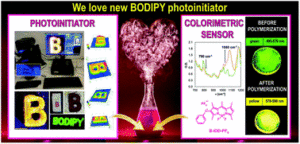Ortyl et al. develop and implement new BODIPY-based derivatives as panchromatic, single-component polymerization photoinitiators.
Light is undeniably a fundamental tool for diverse chemical transformations in organic and polymer chemistry. Photopolymerization processes in particular, have gained widespread interest as they provide powerful, green methodologies for a variety of processes dealing with (bio)materials production, especially those involving 3D printing processes. In this aspect, due to their initiation efficiency, single-component photoinitiators are of particular interest. However, most known cationic photoinitiators have poor matching of their absorption characteristics with the emission characteristics of industrial UV light sources, the so-called medium pressure lamps and UV-LED and Vis-LED diodes.
To address this, Ortyl and collaborators developed and tested in 3D printing applications new BODIPY derivatives and more specifically iodonium salts based on a 4,4-difluoro-1,3,5,7,8-pentamethyl-4-bora-3a,4a-diaza-s-indecene (B-1) chromophore. The new tosylate, hexafluorophosphate, hexafluoroantimonate, and triflate iodonium B-1 salts were found initiate cationic photopolymerization with the hexafluoroantimonate derivative showing the highest reactivity. All derivatives were found to efficiently initiate the polymerization of a variety of monomers (such as epoxides, ethers, glycidyls and oxetanes) as well as of hybrid monomers (such as divinyl/triacrylate and diepoxide/triacrylate). Importantly, diodes of wide spectrum could be used as light source in a wavelength range from 365 to 520 nm. The applicability of the novel BODIPY derivative photoinitiators was demonstrated with 3D printing of epoxy and acrylic resins with good resolution. Moreover, the B-1 chromophore could also be used as a olorimetric sensor of the degree of photopolymerization.
In summary, BODIPY-based derivatives were developed as panchromatic, single-component polymerization photoinitiators.
Tips/comments directly from the authors:
- Newly developed cationic photoinitiators based on the BODIPY chromophore effectively initiate various photopolymerization processes.
- The choice of the appropriate concentration of new photoinitiators, current intensity, type of diode, and monomers enable to obtain polymers with a high degree of polymerization (conversions up to even 95%).
- We described the application of the new BODIPy-based photoinitiators for photo-cured 3D printing. But the newly developed photoinitiators can be successfully used in other applications, such as temporary photo-cured coloured fillings for milk teeth for children.
Development of the first panchromatic BODIPY-based one-component iodonium salts for initiating the photopolymerization processes, Polym. Chem., 2021, 12, 6873-6893.
Link to the paper: https://pubs.rsc.org/en/content/articlehtml/2021/py/d1py01263k
You can follow Professor Ortyl on Twitter: @JoannaOrtyl
 Dr. Kelly Velonia is an Advisory Board Member and a Web Writer for Polymer Chemistry. She joined the Department of Materials Science and Technology in 2007. Research in her group focuses on the synthesis and applications of bioconjugates and biopolymers.
Dr. Kelly Velonia is an Advisory Board Member and a Web Writer for Polymer Chemistry. She joined the Department of Materials Science and Technology in 2007. Research in her group focuses on the synthesis and applications of bioconjugates and biopolymers.











